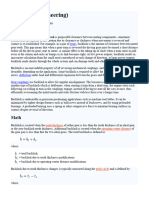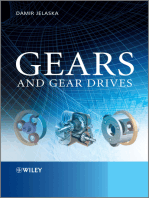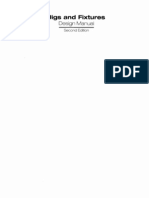Even The Worm Will Turn
Even The Worm Will Turn
Uploaded by
nagaraj.ss@quest-global.comCopyright:
Available Formats
Even The Worm Will Turn
Even The Worm Will Turn
Uploaded by
nagaraj.ss@quest-global.comOriginal Description:
Original Title
Copyright
Available Formats
Share this document
Did you find this document useful?
Is this content inappropriate?
Copyright:
Available Formats
Even The Worm Will Turn
Even The Worm Will Turn
Uploaded by
nagaraj.ss@quest-global.comCopyright:
Available Formats
Power Transmission: Even the Worm Will Turn
Page 1
print | close
Power Transmission: Even the Worm Will Turn
Motion System Design Elisabeth Eitel
Elisabeth Eitel, Engineer Editor
Thu, 2004-01-01 12:00
Think worm gearing is a moderately efficient way to get motion done? The humble worm gear is proving that its full potential has not been realized just yet
Worm gears are a power transmission standard, driving millions of axes requiring more drastic speed reductions. In this type of gearing a longer, more cylindrical worm (which resembles a screw) engages a flatter, more discus worm gear, also known as a worm wheel. The worm typically acts as the driver, and the wheel as driven axis. Unlike other gear designs, worm sets are usually unidirectional: while a worm can drive its wheel, worm systems should not be wheel-driven. This is because worm angles are often so shallow that static friction resulting between the worm and wheel holds the system in place. (Though this acts as a crude brake, it is not recommended to use the worm system as a braking mechanism auxiliary backstops, holdbacks, and conventional brakes are the safest choice.) The worm wheel axis is at a right angle to the worm axis, and both are hobbed to mate. How teeth are cut determines the direction of rotation. The worm is typically threadmilled or rolled, while the worm wheel is hobbed to mate. Worm gear sets are the most common right-angle reducers. The speed ratio of the two engaged shafts is large generally over three, but sometimes even to 300:1. Relatively small worm gear sets can produce these large speed reductions with high torque output; geometric advantages such as large shafts, stronger worm and wheel materials, and one-stage gearing also help achieve higher ratios. However, singlereduction drives are inherently less inefficient as low as 60%. Some newer worm gear sets utilize multiple gear stages to accomplish the same overall ratios, but at efficiencies up to 97%.
Globoids
Often worm gear sets are made so that the teeth of the worm, wheel, or both are curved. A gear with this profile partially wraps around its mate for increased tooth mesh. Called enveloping or globoid, these gear sets are preferred. Specifically, the double-globoid worm gear has been the dominant design since the 1920s. Double-globoid sets feature not only curved-top wheel teeth, but also hyperboloid worm teeth to better mate with the wheel. These features yield higher load capacities, because meshing several gear teeth at once multiplies transmitted torque. But many teeth in mesh is accompanied by reduced areas of tooth contact and in turn, limited torque-carrying gains. (For this reason double-globoids are less common outside the U.S.) Lubrication between the worm and gear is improved with this design because of better mesh contact directions relative to worm rotation. The tradeoff here: for improved mating the worms of double-globoids must be made with special, costlier tools. Double-globoids are sensitive to axial displacements (for example, caused by thermal warping) and require better mounting accuracy than standard cylindrical worms. The mating area between wheel and enveloping worm elongates for a small portion of the wheel width. As a result, the sliding speeds of the upper and lower mating zone areas are very different. Accurate assemblyis crucial (in the relative direction) to make sure alignment is accurate. The median wheel axis and worm axis must line up; more so, the median worm and wheel axes. Misalignments create load concentrations that increase wheel pitting and abrasion. Though the precise amount of wear depends on input speed, rubbing increases with reduced output.
http://machinedesign.com/print/technologies/power-transmission-even-worm-will-turn
5/6/2013 6:16:00 PM
Power Transmission: Even the Worm Will Turn
Page 2
Cylindric worms on globoid wheels have proven a suitable compromise. Such systems offer most of the benefits of double-enveloping systems while avoiding some of the drawbacks. They are widely used in servo applications, especially for precision handling, servo feeding, and high-performance adjustment axes.
Tooth and nail for performance
Tooth forms for worm gearing are not as standardized as other gear systems. In the U.S. worms are typically machined with a straight-side grinding machine, while in other countries worm members are commonly involute helicoids. Another difference: wheel pitch diameter divided by worm pitch diameter is almost never equal to their ratio. (Instead, the number of worm gear teeth divided by the number of worm threads determines the ratio.) Due to the tendency of wheels to wear and seat into worms, common factors between the number of worm threads and wheel teeth are avoided; this prevents repeated, identical engagement and concentrated wear in one location.
Of all worm tooth shapes, the involute is the most common. Because they are easy to manufacture, they are widely available and described in detail in AGMA and DIN standards. The worm teeth are usually thinned to fight backlash. But even after three-quarters of a century, worm gearing is not fully optimized; research continues to uncover design advantages. What is the worms biggest challenge? Sliding worm teeth provide smooth operation, but at the cost of generated heat. This lower efficiency (and higher rate of wear) has been addressed with increased leads. Newer vee-shaped teeth also improve performance. A slightly hollow flank profile is key: For any given transmitted torque, the large contact area minimizes the Hertzian stress (or surface pressure) on the worm. This makes for higher nominal, acceleration, and emergency- stop torques. Improved torque transmission between worm and wheel also increases efficiency, minimizing power loss, which allows for higher speeds in continuously running applications. So significant is the new design that the DIN standard in Europe is being changed to include it. Special thanks to Ralph Whitley, Director of Engineering Boston Gear (of Colfax) for helpful input.>>(617)328-3300.
Source URL: http://machinedesign.com/technologies/power-transmission-even-worm-will-turn
http://machinedesign.com/print/technologies/power-transmission-even-worm-will-turn
5/6/2013 6:16:00 PM
You might also like
- Thread Make-Up ProcedureDocument5 pagesThread Make-Up ProcedureVova PanchenkoNo ratings yet
- UENR88650001Document133 pagesUENR88650001sami akermi100% (1)
- Gear Metrology ReportDocument59 pagesGear Metrology Reportsanjay261289100% (1)
- Project Report: "Financial Statement in Haldiram Snacks PVT - LTD."Document98 pagesProject Report: "Financial Statement in Haldiram Snacks PVT - LTD."DEEPAK80% (5)
- DISCRIPTIONDocument8 pagesDISCRIPTIONRanu GamesNo ratings yet
- Spur Gears Pro Vs ConsDocument8 pagesSpur Gears Pro Vs ConsJohannes WallaceNo ratings yet
- No Backlash DrivesDocument28 pagesNo Backlash Drivesmustafa taiforNo ratings yet
- Helical GearsDocument3 pagesHelical GearsDHAMODHARANNo ratings yet
- Lecture # 01 Introduction To GearsDocument18 pagesLecture # 01 Introduction To GearsMuhammad QasimNo ratings yet
- Gear System: Shri Balwant Institute of TechnologyDocument12 pagesGear System: Shri Balwant Institute of TechnologySreejith BabuNo ratings yet
- CarbonelDocument10 pagesCarboneljimcarbonel05No ratings yet
- Wormgear & WheelsDocument7 pagesWormgear & WheelscagayanalNo ratings yet
- 4.0 Gears: Introduction: The Slip and Creep in The Belt or Rope Drives Is A Common Phenomenon, in TheDocument50 pages4.0 Gears: Introduction: The Slip and Creep in The Belt or Rope Drives Is A Common Phenomenon, in TheSham SundarNo ratings yet
- Spur GearDocument4 pagesSpur GearUmar SahilNo ratings yet
- Gyroscopic Effect (Theory of Machines E-Note 10122015 030631AM)Document18 pagesGyroscopic Effect (Theory of Machines E-Note 10122015 030631AM)Vasudev GuptaNo ratings yet
- Gears Their Designs & Uses: Andrei Lozzi 2012Document23 pagesGears Their Designs & Uses: Andrei Lozzi 2012atulsemiloNo ratings yet
- Final GearsDocument117 pagesFinal GearsJustin Alvin P. CaballaNo ratings yet
- Worm GearDocument29 pagesWorm GearSolai RajanNo ratings yet
- Backlash (Engineering) - Wikipedia, The Free EncyclopediaDocument4 pagesBacklash (Engineering) - Wikipedia, The Free EncyclopediadarkruseNo ratings yet
- 4.0 Gear 4.1 Kinematics of GearsDocument6 pages4.0 Gear 4.1 Kinematics of Gearsnabil foadNo ratings yet
- Case Study DesignDocument12 pagesCase Study DesignAmir Fikri Amran33% (3)
- Lubrication of GearsDocument35 pagesLubrication of GearsMohamed Abdelsalam100% (1)
- Dme Ii Oral QuestionDocument8 pagesDme Ii Oral QuestionSanket ThoratNo ratings yet
- 19FTM05. Design of A Double Spiral Bevel Gearset: ISBN: 978-1-64353-044-4Document1 page19FTM05. Design of A Double Spiral Bevel Gearset: ISBN: 978-1-64353-044-4gioNo ratings yet
- Gear CuttingDocument56 pagesGear Cuttingiyerrahul2679350% (2)
- Analysis of Spur Gear Using Composite MaterialDocument9 pagesAnalysis of Spur Gear Using Composite MaterialIJRASETPublicationsNo ratings yet
- Advantages and Disadvantages of GearsDocument3 pagesAdvantages and Disadvantages of GearsRonald Patricio Vaca GuadalupeNo ratings yet
- CouplingDocument5 pagesCouplingAnonymous 0v9zwXz6hFNo ratings yet
- Gears and Gear TrainsDocument127 pagesGears and Gear TrainsVikki KotaNo ratings yet
- Kinematic of Machines - Gear 1Document8 pagesKinematic of Machines - Gear 1Safdar Ali NiaziNo ratings yet
- Cycloidal GearingDocument2 pagesCycloidal GearingKumar ShashwatNo ratings yet
- UntitledDocument34 pagesUntitledRA H U LNo ratings yet
- How Does A Gearbox Work?Document10 pagesHow Does A Gearbox Work?ihatethisshitNo ratings yet
- Types of Couplings and Their ApplicationsDocument12 pagesTypes of Couplings and Their ApplicationsApple StarkNo ratings yet
- Design and Analysis of A Propeller Shaft of A Toyoto QualisDocument118 pagesDesign and Analysis of A Propeller Shaft of A Toyoto QualisSyed Hasan100% (2)
- Kinematics of GearsDocument4 pagesKinematics of GearsSABEASNNo ratings yet
- 04.01 - GearsDocument8 pages04.01 - GearsRaja MohamedNo ratings yet
- Report On GearDocument18 pagesReport On GearShubham KhannaNo ratings yet
- Bda20303 Chapter 1-Gear SystemDocument27 pagesBda20303 Chapter 1-Gear SystemWan SamiraNo ratings yet
- Gear - WikipediaDocument23 pagesGear - WikipediaChetan PrajapatiNo ratings yet
- Project ANSYS WORMDocument5 pagesProject ANSYS WORMAditya DeyNo ratings yet
- Backlash InglêsDocument2 pagesBacklash Inglêspateta50No ratings yet
- Reduction GearDocument19 pagesReduction GearSatyam KumarNo ratings yet
- Encyclopedia of GearsDocument24 pagesEncyclopedia of GearssulemaanNo ratings yet
- Kassahun Tadess GeerboxDocument16 pagesKassahun Tadess Geerboxabubekery61No ratings yet
- GearsDocument14 pagesGearsZulhilmi Chik TakNo ratings yet
- Introduction of GearsDocument9 pagesIntroduction of Gearsharshjadwani77No ratings yet
- Chapter 6: Mechanical Equipment Maintenance 6.2 GEARSDocument5 pagesChapter 6: Mechanical Equipment Maintenance 6.2 GEARSChee Onn0% (1)
- Gear BoxDocument60 pagesGear Boxkgupta27100% (2)
- Coupling - WikipediaDocument40 pagesCoupling - WikipediaManojkumarNo ratings yet
- Chapter 2-Gear SystemDocument26 pagesChapter 2-Gear SystemNui Yuhu KuwNo ratings yet
- Lab Report 8Document4 pagesLab Report 8moudditNo ratings yet
- Belt DriveDocument16 pagesBelt DriveRuben Ruiperez Salas100% (1)
- Flexible ConnectorsDocument10 pagesFlexible ConnectorsEdward Simon ResterioNo ratings yet
- Bearings And Bearing Metals: A Treatise Dealing with Various Types of Plain Bearings, the Compositions and Properties of Bearing Metals, Methods of Insuring Proper Lubrication, and Important Factors Governing the Design of Plain BearingsFrom EverandBearings And Bearing Metals: A Treatise Dealing with Various Types of Plain Bearings, the Compositions and Properties of Bearing Metals, Methods of Insuring Proper Lubrication, and Important Factors Governing the Design of Plain BearingsRating: 4 out of 5 stars4/5 (1)
- Farm Machinery - Tractors - A Collection of Articles on the Operation, Mechanics and Maintenance of TractorsFrom EverandFarm Machinery - Tractors - A Collection of Articles on the Operation, Mechanics and Maintenance of TractorsNo ratings yet
- Wood Turning - The Lathe and Its Accessories, Tools, Turning Between Centres Face-Plate Work, Boring, PolishingFrom EverandWood Turning - The Lathe and Its Accessories, Tools, Turning Between Centres Face-Plate Work, Boring, PolishingNo ratings yet
- The Ford SOHC Pinto & Sierra Cosworth DOHC Engines high-peformance manual: For Road & TrackFrom EverandThe Ford SOHC Pinto & Sierra Cosworth DOHC Engines high-peformance manual: For Road & TrackNo ratings yet
- How to Power Tune Harley Davidson 1340 Evolution Engines: For Road & TrackFrom EverandHow to Power Tune Harley Davidson 1340 Evolution Engines: For Road & TrackNo ratings yet
- How to Power Tune the BMC/BL/Rover 998 A-Series Engine for Road and TrackFrom EverandHow to Power Tune the BMC/BL/Rover 998 A-Series Engine for Road and TrackNo ratings yet
- A Book of Helpful Tips on Overhauling a Vintage Engine - Including Car, Motorbike and Lawn Mower EnginesFrom EverandA Book of Helpful Tips on Overhauling a Vintage Engine - Including Car, Motorbike and Lawn Mower EnginesRating: 5 out of 5 stars5/5 (1)
- DB51 BTP 160 8PDocument1 pageDB51 BTP 160 8Pnagaraj.ss@quest-global.comNo ratings yet
- Turkred Globoid WormgearingDocument3 pagesTurkred Globoid Wormgearingnagaraj.ss@quest-global.comNo ratings yet
- Gear ManualDocument62 pagesGear ManualAngeles SotoNo ratings yet
- ORD 5700 Parker O-Ring HandbookDocument292 pagesORD 5700 Parker O-Ring Handbookcalaverilandia100% (1)
- Jigs and Fixtures JoshiDocument252 pagesJigs and Fixtures JoshiVikram Govindarajan83% (6)
- Sanitation Practice of BRGY. Militar, Palayan City Nueva EcijaDocument30 pagesSanitation Practice of BRGY. Militar, Palayan City Nueva EcijaArwin daniel TamayoNo ratings yet
- Tableau Shortcuts 【 100+ Tableau keyboard Shortcuts 】Tableau TutorialDocument7 pagesTableau Shortcuts 【 100+ Tableau keyboard Shortcuts 】Tableau TutorialDimitris KosmidisNo ratings yet
- SOP AdeelDocument2 pagesSOP AdeelAdeel SohailNo ratings yet
- GSK218M Programming Operation ManualDocument327 pagesGSK218M Programming Operation ManualMiguel DiazNo ratings yet
- BWB TRC April 28 To May 1 Logistics (Transportation and Lodging)Document4 pagesBWB TRC April 28 To May 1 Logistics (Transportation and Lodging)Black Women's BlueprintNo ratings yet
- U2Z.1.20240521.4 OkDocument1 pageU2Z.1.20240521.4 Oknovitasaridwi063No ratings yet
- Casement AdjustmentDocument9 pagesCasement AdjustmentDickNo ratings yet
- Pakistan Science Innovation ReviewDocument139 pagesPakistan Science Innovation ReviewTayyab HussainNo ratings yet
- Indian Institute of Technology, Kharagpur: Option For IEM Subjects For Semester No.8Document1 pageIndian Institute of Technology, Kharagpur: Option For IEM Subjects For Semester No.8Rahul RoyNo ratings yet
- Hvac - Centralized AC SystemDocument21 pagesHvac - Centralized AC SystemVala Vraj M.No ratings yet
- The Great DepressionDocument26 pagesThe Great Depressionapi-238207999No ratings yet
- ME1823 - Properties of Pure SubstancesDocument23 pagesME1823 - Properties of Pure SubstancesNadun Sasanga KumarasingheNo ratings yet
- D6CA H GuideDocument79 pagesD6CA H GuideT N100% (9)
- Chicago Tribune 1407Document36 pagesChicago Tribune 1407Sara GarboNo ratings yet
- Sony Str-km2 Str-km3 Ver1.1Document82 pagesSony Str-km2 Str-km3 Ver1.1Bernardo RochaNo ratings yet
- Cat 3800 Legris enDocument28 pagesCat 3800 Legris enbelenNo ratings yet
- PdfdocumentDocument1 pagePdfdocumentsagar imsNo ratings yet
- Better Photography November 2015Document100 pagesBetter Photography November 2015wellingtonalvessousa100% (3)
- 12 TWO-k FACTORIAL DESIGN-compressedDocument29 pages12 TWO-k FACTORIAL DESIGN-compressedAnggi Tirta SariNo ratings yet
- Potentialities of Contemporary Earth Construction Addressing Urban Housing Crisis in AfricaDocument9 pagesPotentialities of Contemporary Earth Construction Addressing Urban Housing Crisis in AfricayawperekoNo ratings yet
- Geith Coupler Operation Manual-1Document44 pagesGeith Coupler Operation Manual-1musaferfazal777No ratings yet
- Employee Job Satisfaction at RBKMUL Chapter 2Document76 pagesEmployee Job Satisfaction at RBKMUL Chapter 2Raksha RakshuNo ratings yet
- Control PFDocument110 pagesControl PFMauro010461No ratings yet
- INSIGHT Parents Guide 2023Document24 pagesINSIGHT Parents Guide 2023Rukia28No ratings yet
- Globe Telecom Balance SheetDocument8 pagesGlobe Telecom Balance SheetDeanne GuintoNo ratings yet
- The 5 Most Common Misconceptions About SwiftUI Matteo ManferdiniDocument19 pagesThe 5 Most Common Misconceptions About SwiftUI Matteo ManferdiniDaniel YuenNo ratings yet
- Engineering Materials and Metallurgy (ME 2253)Document23 pagesEngineering Materials and Metallurgy (ME 2253)Praven KumarNo ratings yet






























































































